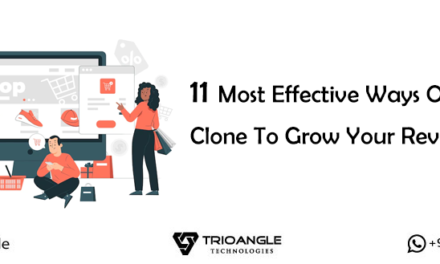The global business-to-business (B2B) e-commerce market will reach nearly $21 trillion by 2027. Despite business-to-business (B2B) platforms being less advanced compared to business-to-customer (B2C) platforms, the value of the B2B market in 2020 was five times greater than the B2C market.
While Alibaba and Amazon continue to dominate the global online shopping landscape, new players are emerging and finding ways to secure competitive positions. In just a few years, the number of B2B marketplaces in Europe has surged from 20 to over 300. These new platforms often focus on specific niches, delivering an excellent user experience.
If you envision developing a B2B e-commerce script, this blog is tailored for you. Here, we’ll cover every aspect of building an online shopping marketplace. Read on!
Understanding “B2B E-Commerce”
B2B e-commerce stands for business-to-business electronic commerce. It’s a platform that facilitates the exchange of products or services between businesses over the Internet.
These platforms typically offer features like catalog management, inventory tracking, order management, and payment processing. Businesses can utilize the B2B e-commerce script to establish vendor accounts, handle purchase orders, and monitor shipments.
The digital processing of orders enhances buying efficiency and effectiveness for wholesalers, manufacturers, distributors, and other B2B sellers. The multi-vendor enables companies to streamline procurement processes, cut costs, and enhance overall efficiency.
Types of B2B E-Commerce
Now that you understand the concept of B2B e-commerce. Next, you need to determine the type of B2B platform that aligns with the vision for your future site. Here are some established types of B2B marketplaces:
- Supplier-Oriented Marketplace: In this type, the marketplace is controlled by suppliers who set up storefronts and manage transactions. Examples include ThomasNet and Alibaba.
- Buyer-Oriented Marketplace: Here, buyers take control by setting up storefronts and managing transactions. Examples include Ariba and Procurify.
- Intermediary-Oriented Marketplace: Intermediaries play a crucial role in matching buyers and sellers. Examples include TradeKey and Global Sources.
- Collaborative Platform: In this type, businesses collaborate to create custom products or services. Examples include Ponoko and GrabCAD.
- Private Industrial Network: Businesses create a private network to exchange goods and services in this type of B2B e-commerce. Examples include Elemica and Exostar.
- Integrated Suites: These are comprehensive online shopping solutions covering everything from procurement to customer service. Examples include SAP and Oracle.
Note that these types are not exhaustive, and some platforms may combine multiple approaches based on their business model and objectives.
Now let’s delve into the 6 vital tactics to build a successful multi-vendor script.
6 Tips to Follow to Build a Successful B2B E-Commerce Script
Building a successful e-commerce marketplace involves careful planning and consideration of various factors. Here are six tips that you should follow while building a B2B script:
Understand Your Target Audience
To effectively build your online marketplace, it is important to gain a comprehensive understanding of your target audience. Start by identifying their specific needs and preferences. Understand their pain points, challenges, and expectations within the B2B landscape.
This knowledge will guide the features and functionalities you need to incorporate into your online shopping platform that precisely address and meet the unique demands of your audience.
Streamline User Experience (UX)
To enhance the purchasing experience, it’s important to prioritize a streamlined user experience (UX) in your online shopping platform. Recognize that buyers often have complex purchasing processes.
Ensure that your platform offers a user-friendly interface by integrating features such as intuitive navigation, a clean layout, and seamless access to detailed product information. These elements collectively contribute to an improved overall user experience and facilitate a smoother and more efficient shopping experience for your customers.
Customization and Flexibility
B2B transactions often involve negotiated pricing, bulk orders, and custom configurations. To accommodate these varied needs, ensure your B2B e-commerce script provides flexibility in pricing models, diverse payment options, and the ability for customers to customize their orders.
This flexibility will address the specific requirements of your customers and make your platform more attractive.
Seamless Integration with Existing Systems
Recognizing that many B2B companies depend on established backend systems like enterprise resource planning (ERP) and customer relationship management (CRM). Ensure your e-commerce script seamlessly integrates with these systems to provide a cohesive and efficient business process.
This integration can help automate workflows, reduce manual errors, and improve overall operational efficiency.
Security and Compliance
Security is paramount in online transactions, especially when dealing with sensitive information and large financial transactions.
To prioritize security in your online shopping marketplace, implement robust security measures, such as SSL encryption, secure payment gateways, customer data encryption, and compliance with industry standards. This protects your customers from potential risks and builds trust in your platform.
Responsive Customer Support
In the digital shopping pace, buyers often require personalized assistance and support for seamless transactions.
Provide multiple channels for customer support in your B2B e-commerce script, such as live chat, email, and phone support. A responsive customer support team plays a crucial role in addressing queries, assisting in the purchasing process, and resolving any issues promptly.
This commitment to prompt and personalized assistance contributes to customer satisfaction and promotes long-term loyalty among your customers.
Sum up
By incorporating these 6 tips into your development process, you can create a powerful and reliable B2B e-commerce marketplace that meets the complex demands of modern business transactions.
Remember, the success of your e-commerce marketplace is an ongoing process. Regularly analyze user feedback, monitor industry trends, and be prepared to adapt and update your platform to meet the evolving needs of your customers.





